South Korean scientists invent beef-infused rice with cow cells



By Carl Samson
South Korean scientists have created rice that contains beef.
What it is: The invention, dubbed “cultured beef rice,” offers a novel protein alternative with enhanced nutritional value and less carbon footprint compared to conventional beef. Researchers from Yonsei University published the method for its creation in the journal Matter on Feb. 14.
How they did it: The researchers first coated rice grains with fish gelatin to facilitate cell adhesion. They then seeded them with cow muscle and fat stem cells. By leveraging the porous and structured nature of the grains — which mimic biological scaffolds found in animals — they created an environment conducive to cell growth and tissue formation. After 9 to 11 days of culturing, they obtained a final product characterized by a distinct texture, nutritional profile and flavor.
The resulting product, which has 8% more protein and 7% more fat than regular rice, is firmer and brittler. The rice that had higher muscle content smelled like beef and almonds, while rice that had higher fat content smelled like cream, butter and coconut oil.
Why this matters: Cultured beef rice presents a solution to challenges associated with traditional meat production. With a smaller carbon footprint and lower production costs, this hybrid food offers a more sustainable and affordable protein source.
First author Sohyeon Park emphasized its potential to revolutionize food production.
“I didn’t expect the cells to grow so well in the rice,” Park said in a news release. “Now I see a world of possibilities for this grain-based hybrid food. It could one day serve as food relief for famine, military ration, or even space food.”
What’s next: The researchers plan to optimize the culturing process to enhance the product’s nutritional value, as well as its taste and texture. Its pink hue, which comes from the medium the grains are cultured in — and not the cow cells — can also be changed to another color.
Share this Article
Share this Article





